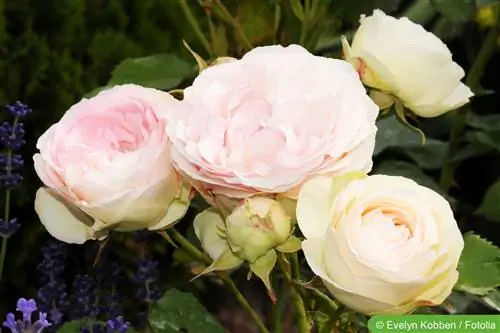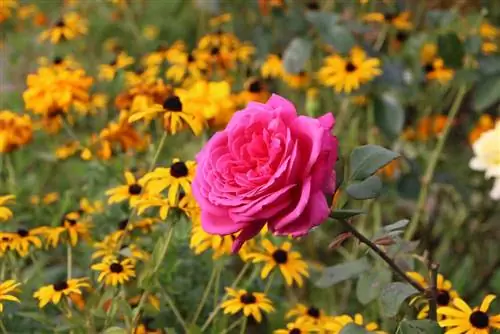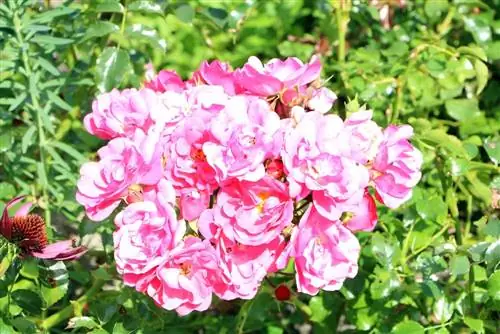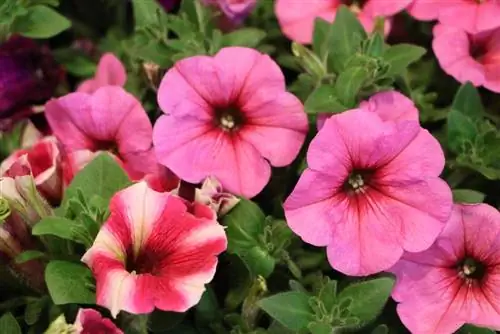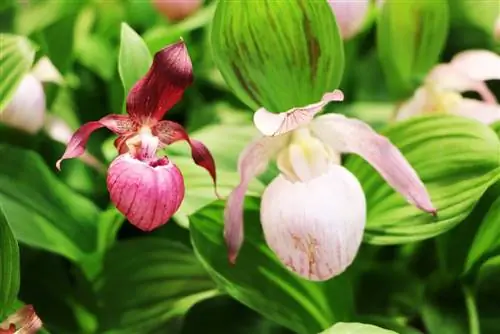- Author admin [email protected].
- Public 2023-12-17 03:39.
- Last modified 2025-06-01 06:48.
English roses are among the most beautiful plants in the garden. Caring for them is usually easier than many hobby gardeners imagine. As is usual with all plants, it is advantageous to find out about the location and soil conditions before planting. The English rose already feels very comfortable with good location conditions and caring for this noble plant is easy.
Choose and prepare a location for English roses
David Austin has probably bred the most beautiful English roses on the market. The variety of flowers, the individual shapes, their scent and, above all, the many beautiful colors are unsurpassable in their beauty. In order for each plant to develop well, a sunny location is recommended. Here the roses should be pampered with at least four to five hours of sunlight.
Before the English rose finally gets its place for the next few years, it is worth preparing the soil well. Depending on the regional soil quality, you can prepare the topsoil a few weeks in advance with organic fertilizer such as humus. It should then rest for some time before the rose plant is planted. Alternatively, it is advisable to use special rose fertilizer. Here too, the time interval recommended by the manufacturer should be adhered to.
Protect English roses from fungal diseases
- Protect the beautiful English roses against fungal diseases by treating the roots with a suitable anti-fungal product before placing the young growth in the planting hole.
- During the final planting, the first centimeters of the shoots that will later develop from the rootstock are well covered with soil.
- When planting, place the rootstock with the root ends spread into the planting hole and press them carefully.
- So that the rose grows well, it is well watered with enough water. 4 to 5 liters of water per plant should be given when planting.
Watering and fertilizing roses
English roses like the beautiful varieties from David Austin have normal care requirements: Care should be taken to water the plant regularly, especially in the first year. This means the small English rose receives enough nutrients and fluid to develop into a magnificent plant. In addition, a slow-release fertilizer for roses or the special fertilizer offered by David Austin is recommended. Give your plant the amount of fertilizer indicated on the manufacturer's packaging before and after flowering, i.e. in spring, approximately three weeks after the first leaves develop and again after the first flowering. This encourages further flowering throughout the season. Additionally, the soil around the plant can be mulched in spring. This provides additional nutrients and reduces rapid dehydration in the warm summer phase.
Enjoy and observe the flowers and scents
During the gardening season is the time to enjoy the beautiful blooms of your English rose while ensuring it stays disease free. You have already laid a good foundation by improving the soil quality and using the correct planting, irrigation and fertilization. Now it's time to protect the rose from mildew or other diseases. If you don't have much experience with roses, it is beneficial to choose a robust variety and give it good care. Since the weather conditions vary from place to place, it is important that you observe your roses and gain experience for the next few years. What are the light and sun conditions? Is the plant perhaps exposed to too much unfavorable wind? Remember that strong winds can also spread diseases from plants. Which locations in your garden are more convenient for planting the next rose? The splendor of the roses also depends to a large extent on your powers of observation and individual experience.
Cutting English roses
Pruning roses is a topic in itself. Many experts in recent years have given detailed instructions on how to prune roses. Make your life easy! Cutting English roses is not a science; it can also be done by the layman. A distinction must be made between shrub roses, bush roses, shrub roses that bloom once, climbing roses and rambler roses. The latter are rarely cut. You are allowed to grow and develop freely. Only the old shoots are removed or tied up. Here too, as with all other roses, the following applies: cut off withered flowers to stimulate the formation of new flowers.
The type of rose determines the cut
The climatic zone plays an important role in the general pruning of roses:
- In areas with mild and frost-free winters, January and February are the appropriate time.
- In cold regions with snow and frost, it is better to wait until the frost-free period before pruning your English roses.
- At this point, diseased or dead shoots as well as old and woody shoots are removed.
- Bush roses will be cut from ¾ to ½, here some main shoots will also be removed.
- The shrub roses that have bloomed once, on the other hand, are rarely cut, if at all only 1/3 of the shoots.
- With the pretty climbing roses, only last year's flowering shoots are cut. As a rule, this is about 15 cm or three to four eyes.
Propagate roses
Seed propagation
Since rose seeds are rarely available in specialist stores, you are usually forced to collect them yourself. The seeds are sown under glass in spring and after just 1 year flowers form on 15cm tall plants. Germinable seeds are usually only obtained from wild species, and usually only if you pollinate them yourself. Rose species that grow on their own roots usually produce strong seedlings, which take about 2-3 years to bloom for the first time.
Propagation of cuttings
Most roses can be propagated from cuttings. Here too, the wild species and their hybrids are best suited. With the English rose, only strong plants are suitable for propagation, as these varieties usually do not form robust shoots and roots, but are grown on strong substrates. Cuttings of English roses can only be cut from well-lignified stems that are approximately pencil-thick. The chances of success are significantly higher if a dozen cuttings of the desired variety are made at once. To do this, 23 cm long cuttings are cut from non-flowering side shoots in late summer or early autumn. Remove all foliage and side shoots except for two to three leaves.
In a partially shaded and protected location, a V-shaped, 15-20 cm deep planting furrow is dug and filled to a depth of 2.5 cm with fine sand. Beforehand, the cut surfaces of the cuttings are carefully dusted with rooting powder and placed in the sand at a distance of approximately 15 cm. Then the cuttings are pressed and carefully watered. The cuttings should have taken root by the fall after next. The cuttings can then be planted in the final location.
Conclusion and further tips on English roses
Ultimately, English roses are hard to beat when it comes to choice of color and scent. Therefore, venture into mixed flower borders to enjoy these exceptionally beautiful plants in all their splendor. They only develop their full beauty when combined with other plants.
- English roses are adaptable. They are therefore particularly suitable for displaying in a mixed flower border.
- Remember that English roses are not hardy and only thrive outdoors in very hot summer climates.
- Their well-formed and elegant flowers smell sweet and pleasant.
- Roses can be propagated by sowing, with cuttings or with special grafting methods, inoculation.
English roses in portrait
- William Shakespeare - shrub rose, crimson red to purple flowers, initially cup-shaped, then flat quartered cup, flower 8 to 10 cm large, growth 100 cm high and 75 cm wide, warm, intense scent, fruity, berry note, good for keeping containers
- Graham Thomas - deep yellow, large, very densely filled flowers, long-term and abundant flowering, strong tea rose scent, grows 120 to 150 cm high and 90 cm wide, strongly bushy, upright and arching, overhanging growth, robust and hardy, resistant, rainproof Blossoms
- Gertrude Jeckyll - pink, rosette-shaped, heavily double flowers, bloom more often, strong scent, grows 120 cm high and 90 cm wide, vigorously bushy, upright growing, very robust, rainproof, also for keeping in containers
- Abraham Darby - shrub rose, pink-apricot to yellow, densely filled flower bowls, up to 11 cm tall, intensely fruity scent, like cassis mango, refreshingly tart note, grows up to 150 cm high and 150 cm wide, bushy growing, particularly rich-flowered and strong-growing shrub

